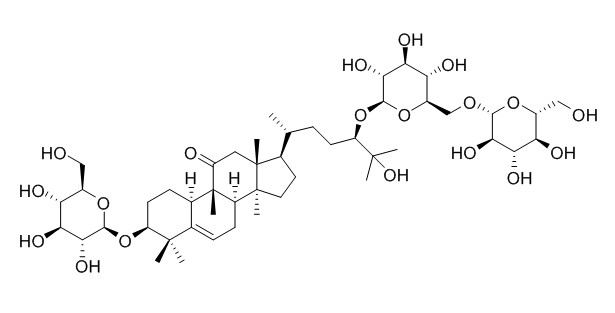11-Oxomogroside III
11-Oxomogroside III is a natural product from Siraitia grosvenorii Swingle.
Inquire / Order:
manager@chemfaces.com
Technical Inquiries:
service@chemfaces.com
Tel:
+86-27-84237783
Fax:
+86-27-84254680
Address:
1 Building, No. 83, CheCheng Rd., Wuhan Economic and Technological Development Zone, Wuhan, Hubei 430056, PRC
Providing storage is as stated on the product vial and the vial is kept tightly sealed, the product can be stored for up to
24 months(2-8C).
Wherever possible, you should prepare and use solutions on the same day. However, if you need to make up stock solutions in advance, we recommend that you store the solution as aliquots in tightly sealed vials at -20C. Generally, these will be useable for up to two weeks. Before use, and prior to opening the vial we recommend that you allow your product to equilibrate to room temperature for at least 1 hour.
Need more advice on solubility, usage and handling? Please email to: service@chemfaces.com
The packaging of the product may have turned upside down during transportation, resulting in the natural compounds adhering to the neck or cap of the vial. take the vial out of its packaging and gently shake to let the compounds fall to the bottom of the vial. for liquid products, centrifuge at 200-500 RPM to gather the liquid at the bottom of the vial. try to avoid loss or contamination during handling.
Planta Med.2019, 85(9-10):766-773
Acta Chromatographica2016, 29(3)
J Pharm Biomed Anal.2022, 207:114398.
Appl. Sci.2020, 10(23), 8729
ACS Pharmacol.Transl.Sci.2024, 4c00003.
J Nat Med.2020, 74(1):65-75
Anticancer Agents Med Chem.2023, 23(10):1204-1210.
Biomed Pharmacother.2019, 116:108987
Research Square2021, 10.21203.
Mol Cells.2015, 38(9):765-72
Related and Featured Products
Se Pu. 2008 Jul;26(4):504-8.
Simultaneous determination of six cucurbitane triterpene glycosides in Siraitia grosvenorii fruits using high performance liqid chromatography.[Pubmed:
18959251]
Siraitia grosvenorii, a traditional Chinese fruit, belongs to the family Cucurbitaceae and has been used as a pulmonary demulcent and emollient for the treatment of dry cough, sore throat, dire thirst, and constipation in folk medicine.
METHODS AND RESULTS:
A high performance liquid chromatographic method was developed for simultaneous determining the contents of mogroside V, mogroside IV A, mogroside III, 11-Oxomogroside III, mogroside II E and 11-oxomogroside II E in Siraitia grosvenorii fruits. The chromatographic analysis was carried out on a ZORBAX SB-C18 column (150 mm x 4.6 mm, 5 microm). The mobile phase was water (A) and acetonitrile (B) with gradient elution (0-3 min, 20% B - 30% B; 3-8 min, 30% B - 35% B; 8-9 min, 35% B). The flow rate was maintained at 0. 8 mL/min. The detection wavelength was set at 203 nm and the column temperature was controlled at 30 degrees C. The sample injection volume was 10 microL. The calibration curves were linear over the ranges of 0.04 - 1.0 mg/mL, 0.011 - 0.68 mg/mL, 0.010 - 0.80 mg/mL, 0.0097 - 0.58 mg/mL, 0.025 - 1.0 mg/mL and 0.013 - 0.76 mg/mL (r > 0.999 1) for the above cucurbitane triterpene glycosides, respectively. The average recoveries were 99. 65% for mogroside V , 101.6% for mogroside IV A, 97. 05% for mogroside m, 103. 1% for 11-oxomogroside I, 99. 25% for mogroside II E, and 103.0% for 11-oxomogroside II E, with the relative standard deviations of 0.83%, 3.1%, 1.9%, 3.3%, 0.59% and 2.0%, respectively.
CONCLUSIONS:
This simple, rapid and accurate method is suitable for quality control and determination of raw materials and products of Siraitia grosvenorii fruits.
Chem Pharm Bull (Tokyo). 2007 Jul;55(7):1082-6.
Cucurbitane glycosides from unripe fruits of Siraitia grosvenori.[Pubmed:
17603208]
METHODS AND RESULTS:
Studies on the constituents of the unripe fruits of Siraitia grosvenori led to the isolation of three new cucurbitane triterpene glycosides, 11-Oxomogroside III (10), 11-dehydroxymogroside III (11), and 11-oxomogroside IV A (12). Their structures were determined on the basis of detailed analyses of 1D, 2D-NMR spectroscopic methods.
CONCLUSIONS:
All of the compounds isolated from the unripe fruits of S. grosvenori were tested for cytotoxic activities against tumor cells, HCT-116 and SMMC-7721.



